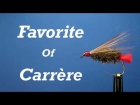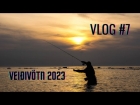Book review: What fish see
A book on fish vision.
This is a book, which I have looked forward to read with great anticipation. I saw it first when a friend--Kim Rasmussen--wrote an article on the color on salmon flies for a Danish magazine, and was quite intrigued by the concept of a more scientific approach to the color of flies.
Colin Kageyama drives the scientific approach right out where it is interesting. His observations on fishes' vision and color perception makes a lot of sense, and the pictures of different objects including flies and lures under water emphasizes all his points. His experiments are extensive and the conclusions indeed intriguing.
A toll
But it takes a toll to read and understand the book, because its subject is not exactly easily accessible. Even though the author does his best to explain and even simplify the concepts, they are inherently complex, and requires some understanding of physics and optics to fully grasp. The author's background as an optometrist also means that his level of knowledge is high, and he obviously tries to convey this knowledge to the reader.
But when you eventually get the ideas and concepts, it is quite satisfying to get some understanding of the connection between light, water color, depth, fly color and the fishes' likely perception of the whole thing. There is a lot of "aha's" and "oh, that's why's" hidden in this book, and the fly tyer and fisher who really wants to construct his flies on a solid, scientific foundation will do himself a great favor by reading it.
The author mentions in several places how this understanding has made him a productive and consistent steelhead angler.
Not a beauty
While the book deals in detail with visual impression it does not itself leave an extremely good one. Even though it mentions the word colors on every second page, it is--like most books--mostly B/W itself.
There are a number of color plates in a small section by themselves, but even though they are highly informative and interesting, they are inconsistent and photographically below the average and not reproduced in a very convincing quality.
This is luckily somewhat outbalanced by the high quality and uniform B/W drawings that illustrate most of the book's points.
Altogether this makes for some interesting and challenging reading, and the book gets a definite GFF recommendation.
Read more about why you should register.
More content from the front page
Since you got this far …
… I have a small favor to ask.
Long story short
Support the Global FlyFisher through several different channels, including PayPal.
Long story longer
The Global FlyFisher has been online since the mid-90's and has been free to access for everybody since day one – and will stay free for as long as I run it.
But that doesn't mean that it's free to run.
It costs money to drive a large site like this.
See more details about what you can do to help in this blog post.



















































